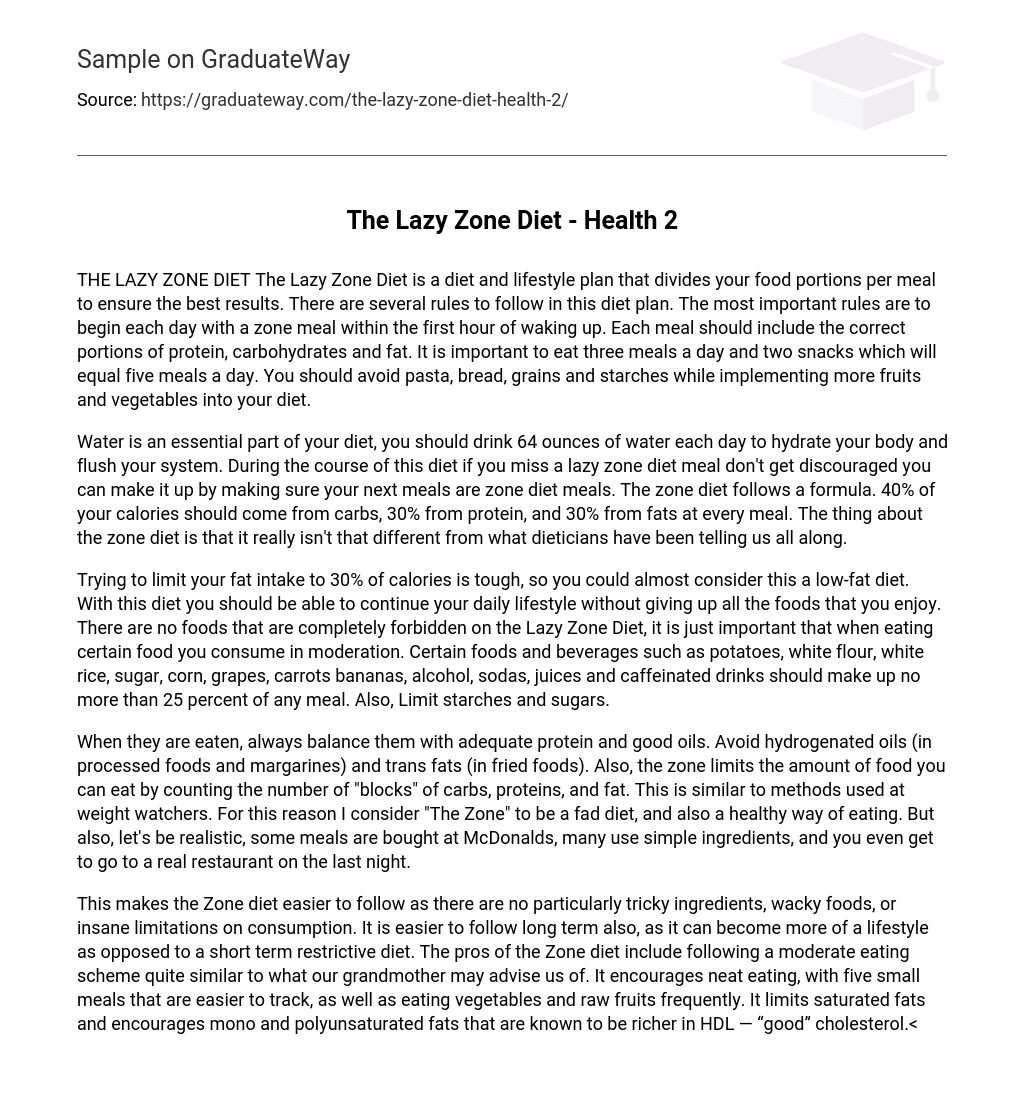Diet is a diet and lifestyle plan that divides your food portions per meal to ensure the best results. There are several rules to follow in this diet plan. The most important rules are to begin each day with a zone meal within the first hour of waking up. Each meal should include the correct portions of protein, carbohydrates and fat. It is important to eat three meals a day and two snacks which will equal five meals a day. You should avoid pasta, bread, grains and starches while implementing more fruits and vegetables into your diet.
Water is an essential part of your diet, you should drink 64 ounces of water each day to hydrate your body and flush your system. During the course of this diet if you miss a lazy zone diet meal don’t get discouraged you can make it up by making sure your next meals are zone diet meals. The zone diet follows a formula. 40% of your calories should come from carbs, 30% from protein, and 30% from fats at every meal. The thing about the zone diet is that it really isn’t that different from what dieticians have been telling us all along.
Trying to limit your fat intake to 30% of calories is tough, so you could almost consider this a low-fat diet. With this diet you should be able to continue your daily lifestyle without giving up all the foods that you enjoy. There are no foods that are completely forbidden on the Lazy Zone Diet, it is just important that when eating certain food you consume in moderation. Certain foods and beverages such as potatoes, white flour, white rice, sugar, corn, grapes, carrots bananas, alcohol, sodas, juices and caffeinated drinks should make up no more than 25 percent of any meal. Also, Limit starches and sugars.
When they are eaten, always balance them with adequate protein and good oils. Avoid hydrogenated oils (in processed foods and margarines) and trans fats (in fried foods). Also, the zone limits the amount of food you can eat by counting the number of “blocks” of carbs, proteins, and fat. This is similar to methods used at weight watchers. For this reason I consider “The Zone” to be a fad diet, and also a healthy way of eating. But also, let’s be realistic, some meals are bought at McDonalds, many use simple ingredients, and you even get to go to a real restaurant on the last night.
This makes the Zone diet easier to follow as there are no particularly tricky ingredients, wacky foods, or insane limitations on consumption. It is easier to follow long term also, as it can become more of a lifestyle as opposed to a short term restrictive diet. The pros of the Zone diet include following a moderate eating scheme quite similar to what our grandmother may advise us of. It encourages neat eating, with five small meals that are easier to track, as well as eating vegetables and raw fruits frequently. It limits saturated fats and encourages mono and polyunsaturated fats that are known to be richer in HDL — “good” cholesterol.
The diet insists on the importance of fresh water, with eight glasses every day are recommended. Zone promotes exercise and consumption of lean meat, which is less dangerous for the heart (fish and poultry instead of beef or pork). No zone diet research has been conducted in a serious, academic manner. If it has, no results have been published. It limits the consumption of foods rich in essential minerals and vitamins: calcium, iron, vitamins A, D, E, folic acid. It limits the consumption of fiber from whole grains and starches.
The zone is considered a low-carb and a low calorie diet. It stimulates loss of glycogen storage (which is 75% water). It deprives the body of its favorite source of energy (glucose) and supplies high amounts of protein. In the burning processes the protein releases nitrogen that can harm the kidneys. It promotes food as a drug, an idea that has nothing to do with aesthetics, cuisine and taste therapy. The idea of eating can become slightly boring or in extremist, traumatizing. Following the recommended ratio of macro nutrients can be difficult, and easy to step out of.
Unfortunately a zone eating scheme places stress on activities such as like dining out, snacking and traveling. Thankfully there are options to be had as long as proper and health conscious choices are made. As with any diet, there are some precautions that must be taken to avoid side effects. In order to properly use the Zone diet, you’ll need to eat every five hours. Your main meals should be large, with two small snacks during the day and at night. Balance each meal and snack by making sure you follow the 40/30/30 rule.





